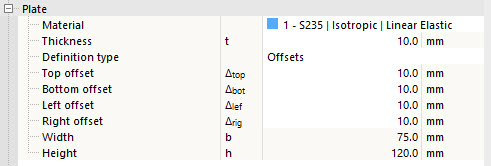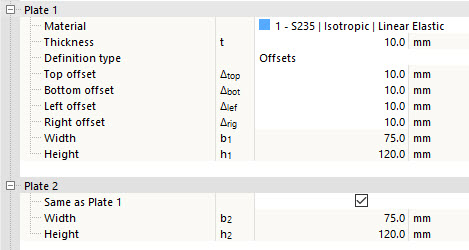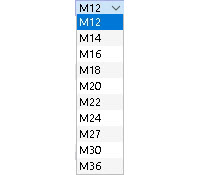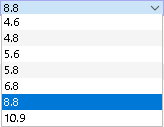The End Plate component allows you to connect a structural component to another one using a bolt group, an end plate, and welds. With this component, it is also possible to connect two structural component with a similar setting.
To Connect
The first category of the component settings manages the definition of the connected component and a reference component.
The first connected component is obligatory. It can be selected from all structural components connected with a node. The second connected component is optional, for example, when another component at the node is to be connected with the same or similar settings. This option is useful when connecting beams with the same cross-section to a supporting component to represent a double shear connection.
The reference component is usually a supporting component. Generally, it is the structural component which the connected components are attached to.
Plate
The next category controls the definition of the end plate. Select the plate material from the defined materials, or create a new material. Then, enter the thickness of the plate.
You can define the dimensions of a rectangular plate by Offsets or by Dimensions and position. Select the relevant option from the list. Circular plates are defined by their diameter.
If you define the end plate by Offsets, its size is derived from the cross-section dimensions of the connected component. That is, how far the end plate overhangs the bounding box of the cross-section. You can check the total plate dimensions in the last rows, but cannot change them.
If you select the Dimensions and position option, you can directly enter the size of the plate. The position of the end plate depends on the connected component: The vertical position is measured from the upper edge of the cross-section (positive values upwards), while the horizontal eccentricity is measured from the center of gravity of the component cross-section.
Switching between the definition types will not change the position or dimensions of the plate. The values are recalculated to reflect the current definition.
Plate 2
If a second connected component has been set, you can define the respective end plate in a similar way.
Bolts
This category manages the properties of the bolts.
Define the bolt diameter and bolt class in the first row by selecting the respective entries from the lists.
In the next two rows, you can define the spacing of the bolts with respect to the horizontal and vertical directions. The edge and center distances are entered in the row separated by spaces. Missing entries are automatically completed in a way that is consistent with the geometry of the end plate.
Activate the Preloaded bolts function to consider prestress. The preloading force factor and the friction coefficient of the end plate are defined in the Ultimate Configuration.
If the Shear plane in thread option is activate, the lower strength (reduced area) according to the selected design standard is considered in the shear design.
Furthermore, you can also deactivate individual bolts in the Bolt list if you want to carry out an irregular bolt pattern.
Welds
The last category controls the welds for the individual parts of the end plate. If you clear the check box, this weld will not be applied.
If you select the space to the right of the check box, you will find a list from which you can select the weld type. There are several types of fillet and butt welds available. For fillet welds, it is necessary to define each thickness.









